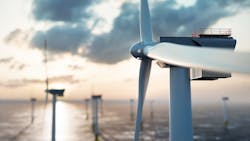DOE Announces US$13.5 Million for Sustainable Development of Offshore Wind
The U.S. Department of Energy (DOE) announced US$13.5 million in funding to provide critical environmental and wildlife data to support offshore wind development. In support of a joint interagency goal to develop 30 GW of offshore wind by 2030, DOE is funding four projects that will inform offshore wind siting, permitting and help protect wildlife and fisheries as offshore wind deployment increases. This latest funding announcement aligns with President Biden’s agenda to catalyze offshore wind energy, strengthen the domestic supply chain, and create good-paying, union jobs.
“Harnessing the incredible potential that exists within offshore wind energy is an essential piece of reaching a net-zero carbon future,” said Secretary of Energy Jennifer M. Granholm. “In order for Americans living in coastal areas to see the benefits of offshore wind, we must ensure that it’s done with care for the surrounding ecosystem by co-existing with fisheries and marine life – and that’s exactly what this investment will do.”
Increased deployment of offshore wind means more clean energy on the grid — which can contribute significantly to the Biden Administration’s goals of 100% carbon-free electricity by 2035 and a net-zero emission economy by 2050. While wind energy will provide significant national economic and environmental benefits, its development and operation may have impacts on the environment and wildlife that need to be assessed.
“This partnership illustrates the Administration’s all-of-government approach to achieve our ambitious clean energy goals, including deploying 30 gigawatts of offshore wind by 2030," said Laura Daniel-Davis, principal deputy assistant secretary for Land and Minerals Management, Department of the Interior. "We are committed to working with our federal partners to ensure that we have the best available science to inform future decisions to help reduce impacts to marine life and other ocean users.”
Two selected projects will support wildlife and fisheries monitoring efforts on the East Coast. The other two projects are focused on preparing the West Coast for floating offshore wind development by collecting wildlife distribution data and developing tools to monitor the environmental effects of floating offshore wind energy. The selectees are:
- Duke University and team (Durham, NC) will assess the risk that offshore wind development may pose to birds, bats, and marine mammals; prioritize wildlife monitoring needs; and collect biological and behavioral data at offshore wind farms on the East Coast. (Award amount: US$7.5 million)
- Coonamessett Farm Foundation and partners (East Falmouth, MA) will survey changes in commercial fish and marine invertebrate populations and seafloor habitats at an offshore wind development site on the East Coast. (Award amount: US$3.3 million)
- Oregon State University (Newport, OR) will conduct visual surveys and acoustic monitoring of marine mammals and seabirds to develop predictive density maps of species present in potential wind energy development areas on the West Coast. (Award amount: US$2 million)
- Woods Hole Oceanographic Institution (Woods Hole, MA) will develop next‐generation autonomous robotic technology for environmental monitoring of marine organisms and the seafloor at potential wind energy development areas on the West Coast. (Award amount: US$750,000)
“These innovative Massachusetts institutions will help supercharge our sustainable offshore wind revolution thanks to this Department of Energy funding,” said U.S. Senator Ed Markey (MA). “These grants will help ensure that our clean energy transition in Massachusetts and along the East Coast works hand-in-hand with maintaining the biodiversity of our waters and understanding the relationship between wind and commercial fisheries.”
“Offshore wind presents a key piece of a greener future, and I’m thrilled that OSU has earned this federal investment to apply its top-notch research in Newport to this clean energy source,” said U.S. Senator Ron Wyden (OR), author of the Clean Energy for America Act. “I’m glad the Energy Department has recognized Oregon State can provide the research and data to ensure the development of this clean and sustainable energy source doesn’t hurt our state’s world-renowned coastal fisheries and wildlife.”
“I am pleased that Duke University will receive $7.5 million from the Department of Energy to expand ongoing research into offshore wind and its impact on the environment and wildlife. Offshore wind has the potential to create substantial economic and environmental benefits, and this research will ensure we are properly assessing and mitigating possible effects of development and production on the surrounding environment,” said U.S. Representative David Price (NC-4). “As a senior member of the House Appropriations Committee, I will continue to advocate for robust federal funding towards research that enables a more environmentally sustainable future.”
This opportunity is jointly funded by DOE and the Bureau of Ocean Energy Management (BOEM) in the U.S. Department of the Interior and was developed under the National Oceanographic Partnership Program in coordination with BOEM, the U.S. Fish and Wildlife Service, the National Oceanic and Atmospheric Administration National Marine Fisheries Service, the California Energy Commission, and the California Ocean Protection Council.
To learn more about DOE’s wind energy research, visit the Wind Energy Technologies Office homepage.
